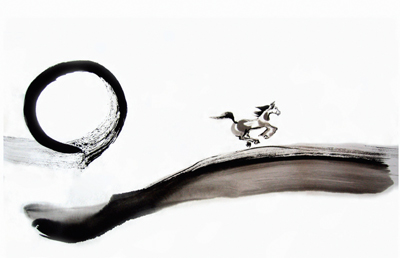
- “Runaway Moon” (SB Gallery, New York, 2010, $30.00 paperback, 48 pp.) is a series of paintings by the artist Minette Mangahas that tell the story of a frightened horse being chased by the moon. The moon morphs into new objects over the course of the night, assuming the shape of drums, a bubble, and a mirror. The paintings, which inspired a multimedia performance at the SOMA theater in San Francisco in 2006, are informed by the Japanese sumi-e style of painting, also known as ink or brush painting. Influenced by Zen artists like Kazuaki Tanahashi and ink painter Chiura Obata, Mangahas taught herself to paint by studying Japanese calligraphy. Her black brushstroke paintings are simple and hauntingly beautiful. Without words to accompany them, the images speak for themselves.
- “The Way of Mountains and Rivers” (Dharma Communications,
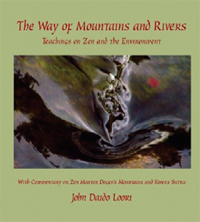 2009, $24.95 paperback, 133 pp.) combines the late John Daido Loori’s photography and poetry with his commentary on thirteenth-century Japanese Zen master Dogen’s “Mountains and Rivers Sutra.” The photographs are powerful visions of nature, offering their own space for contemplation and study, while the simple and direct poetry and commentary evoke a Zen aesthetic. Published shortly before Daido Loori’s death in October, “The Way of Mountains and Rivers” is a reminder of his many talents—as a photographer, naturalist, poet, philosopher, and beloved teacher. “When we thoroughly study the mountains,” Daido Loori writes, “this is the mountain training. Then these mountains and rivers themselves spontaneously become wise ones and sages.”
2009, $24.95 paperback, 133 pp.) combines the late John Daido Loori’s photography and poetry with his commentary on thirteenth-century Japanese Zen master Dogen’s “Mountains and Rivers Sutra.” The photographs are powerful visions of nature, offering their own space for contemplation and study, while the simple and direct poetry and commentary evoke a Zen aesthetic. Published shortly before Daido Loori’s death in October, “The Way of Mountains and Rivers” is a reminder of his many talents—as a photographer, naturalist, poet, philosopher, and beloved teacher. “When we thoroughly study the mountains,” Daido Loori writes, “this is the mountain training. Then these mountains and rivers themselves spontaneously become wise ones and sages.”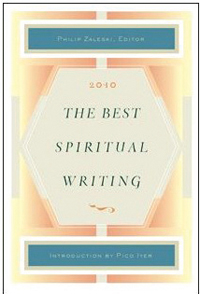
- Each year, Philip Zaleski collects spiritual writing and selects a handful of pieces to publish in one volume. This year’s edition, “The Best Spiritual Writing 2010” (Penguin, 2010, $16.00 paperback, 239 pp.), delivers a wide range of poetry and essays on religion and faith, providing a sort of cross-section of our spirituality. Zaleski’s compilation includes the work of the late John Updike, Jane Hirshfield, and Nobel Prize–winner Seamus Heaney, among many others. Each piece stands on its own, unique in its content and tone, yet bound to the rest by a spiritual thread. As Zaleski writes in the foreward, “Each of us must determine, apart from the clamor and enticements of the world, his own spiritual ground and there take his stand.” These poets and essayists have done just that. As we begin a new decade, “The Best Spiritual Writing” remembers the highlights of 2009 and raises the bar for 2010.
- Right speech—telling the truth,
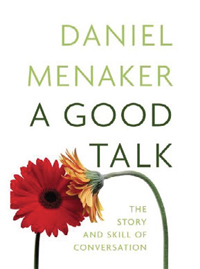 abstaining from idle chatter, and speaking kindly of and to others—is a well-known ethical principle of the Eightfold Path. But what about right conversation? In his new book “A Good Talk” (Twelve Books, 2010, $20.00 hardcover, 230 pp.), Daniel Menaker guides us through what makes conversations work—and what doesn’t. After delving into a brief history of human discourse, Menaker, using his own experiences as the backdrop, reveals the ins and outs of making your way through a conversation. “A Good Talk” is really a how-to—how to make it through a painfully boring chat, how to not be insulted if someone forgets your name, how to gracefully exit a conversation—and Menaker, whose writing for the Shambhala Sun appeared in the 2004 edition of “The Best Buddhist Writing,” proves to be both a humorous and calloused guide on the path toward right conversation.
abstaining from idle chatter, and speaking kindly of and to others—is a well-known ethical principle of the Eightfold Path. But what about right conversation? In his new book “A Good Talk” (Twelve Books, 2010, $20.00 hardcover, 230 pp.), Daniel Menaker guides us through what makes conversations work—and what doesn’t. After delving into a brief history of human discourse, Menaker, using his own experiences as the backdrop, reveals the ins and outs of making your way through a conversation. “A Good Talk” is really a how-to—how to make it through a painfully boring chat, how to not be insulted if someone forgets your name, how to gracefully exit a conversation—and Menaker, whose writing for the Shambhala Sun appeared in the 2004 edition of “The Best Buddhist Writing,” proves to be both a humorous and calloused guide on the path toward right conversation.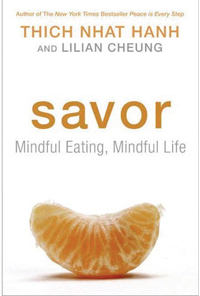
- With chapters like “Are you really savoring your apple? An apple meditation,” “Savor: Mindful Eating, Mindful Life” (HarperOne, 2010, $25.99 hardcover, 304 pp.) is not your average healthyeating guide. A hybrid of Buddhism and nutrition, “Savor” blends the Vietnamese Zen master Thich Nhat Hanh’s teachings with research done by Dr. Lilian Cheung, the director of health promotion and communication at the Harvard School of Public Health’s Department of Nutrition. Divided into three sections, “A Buddhist Perspective on Weight Control,” “Mindful Action Plans,” and “Individual and Collective Effort,” the book introduces Buddhist ideology before delving into specific healthy-living tools, including exercises for untying external (and internal) knots, a ten-week sample mindful-eating plan—even a breakdown of fats. “Savor” may have us rethinking every bite, but maybe that’s just what we need.
- In Zen Buddhism, ox-herding
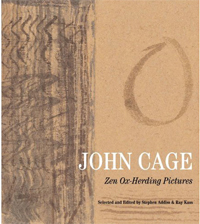 has long served as a metaphor for seeking enlightenment—so long, in fact, that the Zen ox-herding poems date back as far as 1050 CE. In “Zen Ox-Herding Pictures” (George Braziller, 2009, $34.95 hardcover, 128 pp.), the editors Stephen Addiss and Ray Kass bring together fifty never-beforeseen ox-herding paintings by the late composer and artist John Cage. The paintings, inspired by the narrative of the “Ten Oxherding Pictures” painted by the fifteenthcentury Japanese monk-painter Shubun, were done in 1988 on paper towels, test sheets for Cage’s watercolor brush and paint. For almost twenty years, the paper towels sat in the Mountain Lake Workshop archival collection, seen only by a handful of visitors. Now presented in “Zen Oxherding Pictures,” the test sheets have become a body of abstract artwork themselves, and, paired with fragments of Cage’s poetry, they offer a compelling and distinctive take on an ancient metaphor. Whether or not you can find the ox-herder within the abstraction, they are certainly the most beautiful paper towels you’ll ever see.
has long served as a metaphor for seeking enlightenment—so long, in fact, that the Zen ox-herding poems date back as far as 1050 CE. In “Zen Ox-Herding Pictures” (George Braziller, 2009, $34.95 hardcover, 128 pp.), the editors Stephen Addiss and Ray Kass bring together fifty never-beforeseen ox-herding paintings by the late composer and artist John Cage. The paintings, inspired by the narrative of the “Ten Oxherding Pictures” painted by the fifteenthcentury Japanese monk-painter Shubun, were done in 1988 on paper towels, test sheets for Cage’s watercolor brush and paint. For almost twenty years, the paper towels sat in the Mountain Lake Workshop archival collection, seen only by a handful of visitors. Now presented in “Zen Oxherding Pictures,” the test sheets have become a body of abstract artwork themselves, and, paired with fragments of Cage’s poetry, they offer a compelling and distinctive take on an ancient metaphor. Whether or not you can find the ox-herder within the abstraction, they are certainly the most beautiful paper towels you’ll ever see.
Thank you for subscribing to Tricycle! As a nonprofit, we depend on readers like you to keep Buddhist teachings and practices widely available.